Entry Database : PDB / ID : 1ot8Title Structure of the Ankyrin Domain of the Drosophila Notch Receptor Neurogenic locus Notch protein Keywords / / Function / homology Function Domain/homology Component
/ / / / / / / / / / / / / / / / / / / / / / / / / / / / / / / / / / / / / / / / / / / / / / / / / / / / / / / / / / / / / / / / / / / / / / / / / / / / / / / / / / / / / / / / / / / / / / / / / / / / / / / / / / / / / / / / / / / / / / / / / / / / / / / / / / / / / / / / / / / / / / / / / / / / / / / / / / / / / / / / / Biological species Drosophila melanogaster (fruit fly)Method / / / Resolution : 2 Å Authors Zweifel, M.E. / Leahy, D.J. / Hughson, F.M. / Barrick, D. Journal : Protein Sci. / Year : 2003Title : Structure and stability of the ankyrin domain of the Drosophila Notch receptorAuthors : Zweifel, M.E. / Leahy, D.J. / Hughson, F.M. / Barrick, D. History Deposition Mar 21, 2003 Deposition site / Processing site Revision 1.0 Oct 28, 2003 Provider / Type Revision 1.1 Apr 29, 2008 Group Revision 1.2 Jul 13, 2011 Group / Version format complianceRevision 1.3 Oct 27, 2021 Group / Derived calculationsCategory database_2 / pdbx_struct_conn_angle ... database_2 / pdbx_struct_conn_angle / struct_conn / struct_ref_seq_dif / struct_site Item _database_2.pdbx_DOI / _database_2.pdbx_database_accession ... _database_2.pdbx_DOI / _database_2.pdbx_database_accession / _pdbx_struct_conn_angle.ptnr1_auth_asym_id / _pdbx_struct_conn_angle.ptnr1_auth_comp_id / _pdbx_struct_conn_angle.ptnr1_auth_seq_id / _pdbx_struct_conn_angle.ptnr1_label_asym_id / _pdbx_struct_conn_angle.ptnr1_label_atom_id / _pdbx_struct_conn_angle.ptnr1_label_comp_id / _pdbx_struct_conn_angle.ptnr1_label_seq_id / _pdbx_struct_conn_angle.ptnr3_auth_asym_id / _pdbx_struct_conn_angle.ptnr3_auth_comp_id / _pdbx_struct_conn_angle.ptnr3_auth_seq_id / _pdbx_struct_conn_angle.ptnr3_label_asym_id / _pdbx_struct_conn_angle.ptnr3_label_atom_id / _pdbx_struct_conn_angle.ptnr3_label_comp_id / _pdbx_struct_conn_angle.ptnr3_label_seq_id / _pdbx_struct_conn_angle.value / _struct_conn.pdbx_dist_value / _struct_conn.ptnr1_auth_asym_id / _struct_conn.ptnr1_auth_comp_id / _struct_conn.ptnr1_auth_seq_id / _struct_conn.ptnr1_label_asym_id / _struct_conn.ptnr1_label_atom_id / _struct_conn.ptnr1_label_comp_id / _struct_conn.ptnr1_label_seq_id / _struct_conn.ptnr2_auth_asym_id / _struct_conn.ptnr2_auth_comp_id / _struct_conn.ptnr2_auth_seq_id / _struct_conn.ptnr2_label_asym_id / _struct_conn.ptnr2_label_atom_id / _struct_conn.ptnr2_label_comp_id / _struct_conn.ptnr2_label_seq_id / _struct_ref_seq_dif.details / _struct_site.pdbx_auth_asym_id / _struct_site.pdbx_auth_comp_id / _struct_site.pdbx_auth_seq_id Revision 1.4 Feb 14, 2024 Group / Category / chem_comp_bond
Show all Show less
 Open data
Open data Basic information
Basic information Components
Components Keywords
Keywords Function and homology information
Function and homology information
 X-RAY DIFFRACTION /
X-RAY DIFFRACTION /  SYNCHROTRON /
SYNCHROTRON /  MAD / Resolution: 2 Å
MAD / Resolution: 2 Å  Authors
Authors Citation
Citation Journal: Protein Sci. / Year: 2003
Journal: Protein Sci. / Year: 2003 Structure visualization
Structure visualization Molmil
Molmil Jmol/JSmol
Jmol/JSmol Downloads & links
Downloads & links Download
Download 1ot8.cif.gz
1ot8.cif.gz PDBx/mmCIF format
PDBx/mmCIF format pdb1ot8.ent.gz
pdb1ot8.ent.gz PDB format
PDB format 1ot8.json.gz
1ot8.json.gz PDBx/mmJSON format
PDBx/mmJSON format Other downloads
Other downloads 1ot8_validation.pdf.gz
1ot8_validation.pdf.gz wwPDB validaton report
wwPDB validaton report 1ot8_full_validation.pdf.gz
1ot8_full_validation.pdf.gz 1ot8_validation.xml.gz
1ot8_validation.xml.gz 1ot8_validation.cif.gz
1ot8_validation.cif.gz https://data.pdbj.org/pub/pdb/validation_reports/ot/1ot8
https://data.pdbj.org/pub/pdb/validation_reports/ot/1ot8 ftp://data.pdbj.org/pub/pdb/validation_reports/ot/1ot8
ftp://data.pdbj.org/pub/pdb/validation_reports/ot/1ot8 Links
Links Assembly
Assembly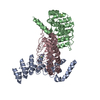
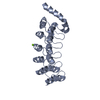
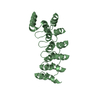
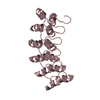
 Components
Components

 X-RAY DIFFRACTION / Number of used crystals: 1
X-RAY DIFFRACTION / Number of used crystals: 1  Sample preparation
Sample preparation SYNCHROTRON / Site:
SYNCHROTRON / Site:  NSLS
NSLS  / Beamline: X25 / Wavelength: 1.1 Å
/ Beamline: X25 / Wavelength: 1.1 Å Processing
Processing MAD / Resolution: 2→20 Å / Cor.coef. Fo:Fc: 0.948 / Cor.coef. Fo:Fc free: 0.938 / SU B: 2.934 / SU ML: 0.083 / TLS residual ADP flag: LIKELY RESIDUAL / Cross valid method: THROUGHOUT / ESU R: 0.141 / ESU R Free: 0.126 / Stereochemistry target values: MAXIMUM LIKELIHOOD
MAD / Resolution: 2→20 Å / Cor.coef. Fo:Fc: 0.948 / Cor.coef. Fo:Fc free: 0.938 / SU B: 2.934 / SU ML: 0.083 / TLS residual ADP flag: LIKELY RESIDUAL / Cross valid method: THROUGHOUT / ESU R: 0.141 / ESU R Free: 0.126 / Stereochemistry target values: MAXIMUM LIKELIHOOD Movie
Movie Controller
Controller





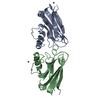
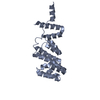

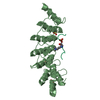
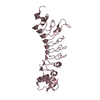
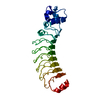

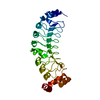
 PDBj
PDBj









